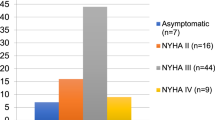Abstract
The management of pediatric and adolescent patients with pure aortic valve regurgitation remains challenging and controversial (Christos et al., Eur J Cardiothorac Surg 17:125–133, 2000; Gersony and Sommerville, ACC Curr J Rev 31:97–98, 2000; Hasaniya et al., J Thorac Cardiovasc Surg 127:970–974, 2004; Sabet et al., Mayo Clin 74:14–26, 1999; Tweddell et al., J Thorac Cardiovasc Surg 129:551–558, 2005). We evaluated pediatric and young adult patients who underwent aortic valve replacement (AVR) primarily for aortic regurgitation in an effort to identify preoperative echocardiographic variables that are predictive of left ventricular (LV) recovery following AVR. Twenty-one patients with severe aortic valve regurgitation who underwent AVR were identified. Retrospective chart review for each patient was performed and transthoracic echocardiograms prior to and 6-months after AVR were analyzed. Improvement in LV size based on preoperative LV end-systolic dimension index when compared to 6-months post-AVR was observed in 68 % of the patients. Patients with persistent dilation of their left ventricles had a greater preoperative LV end-systolic dimension index (p ≤ 0.05), a greater preoperative LV end-systolic dimension z-score (p ≤ 0.002), and a lower preoperative ejection fraction (EF) (p ≤ 0.001). A similar trend was present between the two cohorts in regards to LV end-diastolic parameters (LV end-diastolic dimension index and z-score), with patients with abnormal LV size at 6-month follow-up having larger preoperative dimensions. Increasing LV systolic dimensions and declining EF appear to be predictors of poor LV recovery following AVR in pediatric and young adult patients. LV end-systolic indices appear to be more predictive than LV end-diastolic indices. AVR should be performed prior to severe LV enlargement defined as an LV end-systolic dimension z-score >4.5.



Similar content being viewed by others
References
Bonow RO, Lakatos E, Maron BJ et al (1991) Serial long-term assessment of the natural history of asymptomatic patients with chronic aortic regurgitation and normal left ventricular systolic function. Circulation 84:1625–1635
Christos A, McDonald A, Langley SM et al (2000) Aortic valve replacement in children: are mechanical prostheses a good option. Eur J Cardiothorac Surg 17:125–133
Corti R, Bingelli C, Turina M et al (2001) Predictors of long-term survival after valve replacement for chronic aortic regurgitation. Eur Heart J 22:866–873
Dujardin KS, Enriquez-Sarano M, Schaff HV et al (1999) Mortality and morbidity of aortic regurgitation in clinical practice: a long-term follow-up study. Circulation 99:1851–1857
Fernandes SM, Sanders SP, Khairy P et al (2004) Morphology of bicuspid aortic valve in children and adolescents. J Am Coll Cardiol 44:1648–1651
Gersony WM, Sommerville J (2000) Decision making: when to perform aortic valve replacement in the pediatric patient. ACC Curr J Rev 31:97–98
Hasaniya N, Gundry SR, Razzouk AJ et al (2004) Outcomes of aortic valve repair in children with congenital aortic valve regurgitation. J Thorac Cardiovasc Surg 127:970–974
Lopex L, Colan SD, Frommelt PC et al (2010) Recommendations for quantification methods during the performance of a pediatric echocardiogram: a report from the pediatric measurements writing group of the American Society of Echocardiography Pediatric and Congenital Heart Disease Council. J Am Soc Echocardiogr 23:465–495
Minakata K, Schaff HV, Zehr KJ et al (2004) Is repair of aortic valve regurgitation a safe alternative to valve replacement. J Thorac Cardiovasc Surg 127:645–653
Pettersen MD, Wei D, Skeens ME, Humes RA (2008) Regression equations for calculation of z-scores of cardiac structures in a large cohort of healthy infants, children, and adolescents: an echocardiographic study. J Am Soc Echocardiogr 21:922–934
Sabet HY, Edwards WD, Hentry T et al (1999) Congenitally bicuspid aortic valves: a surgical pathology study of 543 cases (1991 through 1996) and a literature review of 2,715 additional cases. Mayo Clin 74:14–26
Tarasoutchi F, Grinberg M, Spina GS et al (2003) Ten-year clinical laboratory follow-up after application of a symptom-based therapeutic strategy to patients with severe chronic aortic regurgitation of predominant rheumatic etiology. J Am Coll Cardiol 41:1316–1324
Turina J, Milincic J, Seifert B et al (1998) Valve replacement in chronic aortic regurgitation: true predictors of survival after extended follow-up. Circulation 98:100II–106II
Tweddell JS, Pelech AN, Frommelt PC et al (2005) Complex aortic valve repair as a durable and effective alternative to valve replacement in children with aortic valve disease. J Thorac Cardiovasc Surg 129:551–558
Van Son JA, Reddy VM, Black MD et al (1996) Morphologic determinants favoring surgical aortic valvuloplasty versus pulmonary autograft aortic valve replacement in children. J Thorac Cardiovasc Surg 111:1149–1157
Conflict of interest
None.
Author information
Authors and Affiliations
Corresponding author
Rights and permissions
About this article
Cite this article
Cox, D.A., Walton, K., Bartz, P.J. et al. Predicting Left Ventricular Recovery After Replacement of a Regurgitant Aortic Valve in Pediatric and Young Adult Patients: Is It Ever Too Late?. Pediatr Cardiol 34, 694–699 (2013). https://doi.org/10.1007/s00246-012-0529-8
Received:
Accepted:
Published:
Issue Date:
DOI: https://doi.org/10.1007/s00246-012-0529-8




